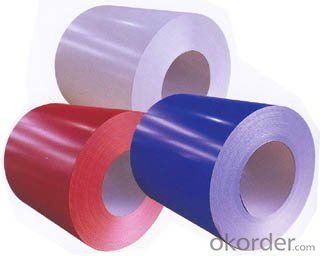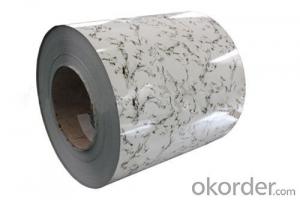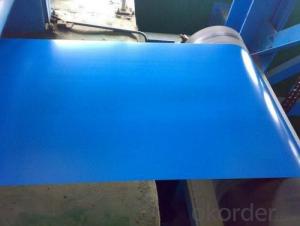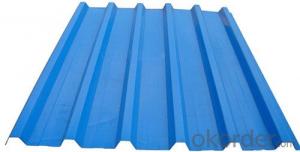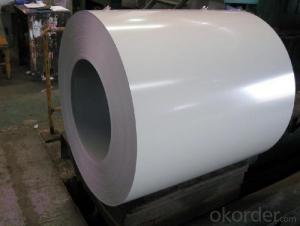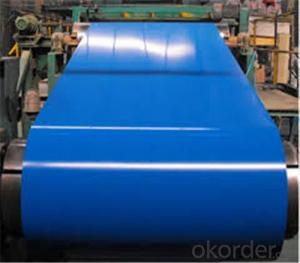Prepainted steel coils, hot-dipped galvanized, RAL system
- Loading Port:
- Shanghai
- Payment Terms:
- TT OR LC
- Min Order Qty:
- 50 m.t.
- Supply Capability:
- 3000 m.t./month
OKorder Service Pledge
OKorder Financial Service
You Might Also Like
Quick Details
| Standard: | AISI,ASTM,BS,DIN,GB | Grade: | SGCC | Thickness: | 0.15-0.6mm |
| Place of Origin: | China (Mainland) | Brand Name: | Model Number: | Steel coil | |
| Type: | Steel Coil | Technique: | Cold Rolled | Surface Treatment: | Coated |
| Application: | Building material | Special Use: | High-strength Steel Plate | Width: | 600-1250mm |
| Length: | accoding to type | Zinc coating: | 40-120g/m2 | Coil ID: | 508/610mm |
| Backside painting: | 7-10mic | Upside painting: | 13-25mic |
Packaging & Delivery
| Packaging Detail: | standard seaworthy export packing: 3 layers of packing, inside is kraft paper, water plastic film is in the middle and outside GI steel sheet to be covered by steel strips with lock, with inner coil sleeve. |
| Delivery Detail: | 15-30days |
Specifications
ppgl steel coil
Thickness: 0.15-0.6mm
Width:600-1250mm
Color:all Ral color
Hardness: Soft to full hard
1.PPGL Steel information
Standard | ASTM A653, JIS G3302,GB/T3830-2006 |
Grade | DX51D,SGCC,SPCC,SGHC |
Thickness | 0.18mm--1.2mm |
Width | 400-1250mm(usual size:914mm,1000mm,1200mm,1219mm,1250mm,) |
Base metal | Galvanized steel coils, |
Zinc coating | 40-80gsm |
Coil ID | 508mm,610mm |
Coating thickness | Top:17-25um back:5-8um |
Color options | Ral number or as per your request |
Packing | Standard seaworthy export packing: 3 layers of packing, inside is kraft paper, water plastic film is in the middle and outside GI steel sheet to be covered by steel strips with lock, with inner coil sleeve. |
Delivery | Within 10-15days after signing contract |
Price | FOB&CNF&CIF price |
Payment terms | TT or L/C |
Monthly supply | 30000MT per month |
Application: | workshop, storeroom, roofing,kiosk... |
- Q: What are the different methods of punching steel coils?
- There are several methods of punching steel coils, including mechanical punching, hydraulic punching, and laser punching. Mechanical punching involves the use of a mechanical press with a punch and die set to create holes or shapes in the steel coil. Hydraulic punching utilizes hydraulic force to drive a punch through the coil, providing high precision and speed. Laser punching, on the other hand, uses a laser beam to cut or form holes in the steel coil, offering great flexibility and accuracy. Each method has its own advantages and suitability depending on the specific requirements of the application.
- Q: What is the role of steel coils in HVAC systems?
- Steel coils play a crucial role in HVAC (heating, ventilation, and air conditioning) systems as they are responsible for facilitating the transfer of heat between the air and the refrigerant. In HVAC systems, steel coils are typically used in two main components: the condenser coil and the evaporator coil. The condenser coil is located in the outdoor unit of an HVAC system and its primary function is to release the heat from the refrigerant into the surrounding air. This coil is made up of multiple steel tubes that are bent into a serpentine shape and are attached to aluminum fins. As the hot refrigerant flows through these tubes, the steel coils ensure maximum surface area contact with the surrounding air, allowing for efficient heat transfer. Through this process, the heat is dissipated into the outdoor environment, resulting in the cooling of the refrigerant. On the other hand, the evaporator coil is situated in the indoor unit of the HVAC system and its role is to absorb heat from the air inside the building. Similar to the condenser coil, the evaporator coil consists of steel tubes that are connected to aluminum fins. The refrigerant, in a cold state, flows through these tubes, and as warm air from the building passes over the coils, the heat is transferred from the air to the refrigerant. This heat absorption process cools down the air, which is then circulated back into the building, providing the desired cooling effect. Overall, steel coils in HVAC systems are essential for heat transfer between the air and the refrigerant. Their design and placement allow for efficient cooling or heating of the air, depending on the system's mode of operation. Without steel coils, HVAC systems would not be able to effectively regulate the temperature and provide the desired comfort levels in residential, commercial, and industrial buildings.
- Q: What are the safety precautions to be taken while handling steel coils?
- When handling steel coils, several safety precautions should be followed to ensure safe practices. These include wearing appropriate personal protective equipment (PPE), such as gloves, safety goggles, and steel-toed boots, to protect against potential hazards. It is important to use proper lifting techniques and equipment, such as forklifts or cranes, to prevent musculoskeletal injuries. Coils should be stored and stacked in a stable manner to avoid toppling or shifting. Additionally, workers should be trained on how to safely handle coils, including being aware of sharp edges, the weight of the coils, and potential pinch points. Regular inspections of equipment and work areas should be conducted to identify and address any potential safety hazards.
- Q: How are steel coils used in the manufacturing of shipping containers?
- Steel coils are used in the manufacturing of shipping containers as they are rolled into sheets, which are then cut and welded to create the walls, roof, and floor of the container. The high strength and durability of steel coils ensure that the shipping containers can withstand the rigors of transportation, protecting the goods inside.
- Q: If you combine stainless steel with gold, does that make stainless gold?
- Nope, Stainless Steel is a tradename for a certain alloy. Regular Steel, which is formed from Ferrous Oxide (via the Bessimer Process). The stainless part is because they mixed in some other compound to give it unique qualities. Gold, on the other hand, is a pure element, and it can form alloys with other metals, but there are no guarantees what the properties will be
- Q: What are the advantages of using steel coils over other materials?
- There are several advantages of using steel coils over other materials. Firstly, steel is highly durable and has a long lifespan, making it ideal for various applications. Secondly, steel coils have excellent strength and can withstand heavy loads and extreme weather conditions. Thirdly, steel is recyclable and environmentally friendly, ensuring sustainability. Additionally, steel coils provide superior corrosion resistance, reducing maintenance costs. Lastly, steel offers versatility in terms of customization, allowing for various shapes, sizes, and thicknesses to meet specific requirements.
- Q: How are steel coils inspected for quality?
- Steel coils are inspected for quality through various methods such as visual inspection, dimensional measurement, and non-destructive testing techniques. These inspections ensure that the coils meet specific quality standards and requirements by examining their surface condition, dimensions, and internal integrity.
- Q: How are steel coils inspected for weldability using welding tests?
- Steel coils can be inspected for weldability using a variety of welding tests. One common method is the bend test, where a section of the coil is cut and bent to evaluate the quality of the weld. This test helps determine if the weld is brittle or contains any defects that could compromise its integrity. Additionally, the guided bend test is performed to assess the ability of the weld to withstand bending without cracking or breaking. Another technique used is the macro etch test, where a sample is prepared by cutting a cross-section of the coil and then etching it with a chemical solution. This test helps reveal any imperfections or inconsistencies in the weld, such as porosity, slag inclusions, or lack of fusion. Furthermore, the hardness test is conducted to measure the hardness of the weld. This is important as excessive hardness can lead to cracking or brittleness, while insufficient hardness may result in weld failure under certain conditions. Additionally, non-destructive testing methods like ultrasonic testing, magnetic particle inspection, or radiographic examination can also be employed to detect any internal defects, such as cracks or voids, in the steel coil welds without damaging the material. These welding tests are crucial in ensuring the quality and weldability of steel coils before they are used in various applications. By conducting thorough inspections, any potential issues can be identified and addressed, ensuring that the steel coils meet the required standards for weldability and structural integrity.
- Q: What are the different cutting methods for steel coils?
- There are several different cutting methods that can be used for steel coils, depending on the specific requirements and desired outcome. Some of the most common cutting methods for steel coils include: 1. Slitting: Slitting is a method that involves cutting the steel coil into narrower strips. This is typically done using a slitting machine that features multiple circular blades. The machine will unwind the coil and pass it through the blades, which will cut it into the desired width. Slitting is commonly used for applications that require narrower strips of steel, such as in the manufacturing of automotive parts or electrical appliances. 2. Shearing: Shearing is a cutting method that involves using a shear machine to cut through the steel coil. The machine will have a straight blade that is pressed against the coil, effectively cutting it into desired lengths or shapes. Shearing is often used for applications that require precise cuts or when the steel coil needs to be cut into specific sizes. 3. Laser cutting: Laser cutting is a more advanced cutting method that uses a high-powered laser to cut through the steel coil. The laser beam is directed onto the coil, melting or vaporizing the metal and creating a clean and accurate cut. Laser cutting is highly precise and can be used to cut intricate designs or patterns into the steel coil. It is often used in industries such as aerospace, automotive, and electronics. 4. Plasma cutting: Plasma cutting is a cutting method that uses a high-velocity jet of ionized gas to melt and remove the metal from the steel coil. The gas is usually a mixture of oxygen and an inert gas, such as nitrogen or argon. Plasma cutting is known for its speed and versatility, as it can cut through a variety of metals, including steel. It is often used in industries that require fast and efficient cutting, such as shipbuilding or construction. These are just a few of the different cutting methods that can be used for steel coils. The choice of method will depend on factors such as the desired outcome, the thickness of the steel coil, and the specific requirements of the application. It is important to consult with a professional or specialist to determine the most suitable cutting method for your specific needs.
- Q: Personally, I like Steel Cage matches to end in pinfalls. One of the biggest selling points of a Cage match is that it is to keep the competitors in and keep others out; essentially ensuring that it's a 1 on 1 match. As a result, I believe that pinfalls or submissions are important - but I know there's a lot of people that believe cage matches should only end in escape. What do you think??
- That exists.. Ts called hell in a cell. And normal cage matches are fine the way they are
Send your message to us
Prepainted steel coils, hot-dipped galvanized, RAL system
- Loading Port:
- Shanghai
- Payment Terms:
- TT OR LC
- Min Order Qty:
- 50 m.t.
- Supply Capability:
- 3000 m.t./month
OKorder Service Pledge
OKorder Financial Service
Similar products
Hot products
Hot Searches
Related keywords



